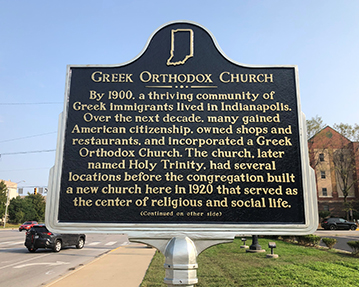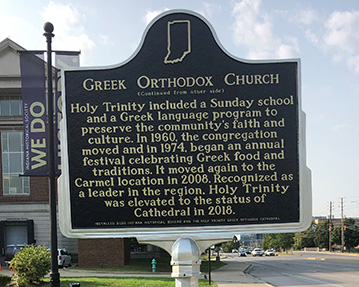

Location: West Street beside the Indiana Historical Society located at 450 W. Ohio Street, Indianapolis (Marion County, Indiana) 46204
Installed 2020 Indiana Historical Bureau and the Holy Trinity Greek Orthodox Cathedral
ID#: 49.2020.3
Text
Side One:
By 1900, a thriving community of Greek immigrants lived in Indianapolis. Over the next decade, many gained American citizenship, owned shops and restaurants, and incorporated a Greek Orthodox Church. The church, later named Holy Trinity, had several locations before the congregation built a new church here in 1920 that served as the center of religious and social life.
Side Two:
Holy Trinity included a Sunday school and a Greek language program to preserve the community’s faith and culture. In 1960, the congregation moved and in 1974, began an annual festival celebrating Greek food and traditions. It moved again to the Carmel location in 2008. Recognized as a leader in the region, Holy Trinity was elevated to the status of Cathedral in 2018.
Annotated Text
Side One:
By 1900, a thriving community of Greek immigrants lived in Indianapolis.[1] Over the next decade, many gained American citizenship, owned shops and restaurants,[2] and incorporated a Greek Orthodox Church.[3] The church, later named Holy Trinity,[4] had several locations[5] before the congregation built a new church here in 1920 that served as the center of religious and social life.[6]
Side Two:
Holy Trinity included a Sunday school and a Greek language program to preserve the community’s faith and culture.[7] In 1960, the congregation moved[8] and in 1974, began an annual festival celebrating Greek food and traditions.[9] It moved again to the Carmel location in 2008.[10] Recognized as a leader in the region, Holy Trinity was elevated to the status of Cathedral in 2018.[11]
All newspapers accessed Newspapers.com unless otherwise noted.
[1] 1900 U.S. Census, Schedule 1, Center Township, Marion County, Indiana, June 1, 1900, accessed AncestryLibrary.
By 1900, a small but thriving community of Greek immigrants lived and worked in Indianapolis. Several worked as candy makers/confectioners; a smaller number worked as boot blacks and day laborers.
[2] 1910 U.S. Census, Indianapolis, Center Township, Marion County, April 16, 1910, AncestryLibrary; 1911 Indianapolis City Directory; 1912 Indianapolis City Directory.
By 1912, many of the Greek born Indianapolis residents had gained American citizenship. Their occupations had diversified as well. The census and city directories listed Greek-born Indianapolis shop owners (fruit store, candy shop, popcorn stand, grocery), workers in barber shops, boot blacks/shoe shiners, a butcher, an electrician, many workers for Belt rail road company, waiters and cooks at restaurants, restaurant owners, bartenders, and saloon owners.
[3] “Lowered into Water; Anointed with Oil,” Indianapolis News, February 2, 1907, 28; “Wanted – Miscellaneous,” Indianapolis News, March 27, 1907, 13; “Greek Priest Here to Conduct Church,” Indianapolis Star, April 14, 1907, 26; “Articles of Incorporation,” Indianapolis News, February 24, 1910, 7; “Incorporations,” Indianapolis Star, February 24, 1910, 14.
In April 1907, the first services of an unnamed Greek Orthodox Church were held at 27 South Meridian. Greek Orthodox priest Nicholas Velonis came from Greece to serve as “300 Greeks far away in Indianapolis who were without church or priest.” In February 1910, the church filed articles of incorporation with the Indiana Secretary of State as “Greek Orthodox church, St. Trinity, Indianapolis.”
[4] “Church Rites Thursday for William J. Kontos,” Indianapolis News, January 7, 1948, 16; “John Pulos Rites to be Held Friday,” Indianapolis News, December 2, 1949, 19; “Obituaries,” Indianapolis News, September 13, 1952, 16; Obituaries in the Indianapolis News and Star, 1952, passim.
The church was incorporated as “St. Trinity” (see footnote 3) but was also called “St. Trias.” By 1948, the congregation was using the name “Holy Trinity Greek Orthodox Church” or “Holy Trinity Hellenic Orthodox Church” instead of “St. Trias,” and by the early 1950s, “St. Trias” had been completely phased out.
[5] “Lowered into Water; Anointed with Oil,” Indianapolis News, February 2, 1907, 28; “Wanted – Miscellaneous,” Indianapolis News, March 27, 1907, 13; “Greek Priest Here to Conduct Church,” Indianapolis Star, April 14, 1907, 26; “Articles of Incorporation,” Indianapolis News, February 24, 1910, 7; “Incorporations,” Indianapolis Star, February 24, 1910, 14; “Plan for Greek Church,” Indianapolis News, February 26. 1910, 2; “Real Estate Transfers,” Indianapolis News, June 19, 1913, 16; “Greek-Americans Organize,” Indianapolis News, May 17, 1915, 7; “Priest After Damages,” Indianapolis News, May 24, 1916, 2; “Church Officials to Air Difficulties in Court,” Indianapolis Star, November 4, 1916, 22; “Money of Greek Church Placed in Grover’s Care,” Indianapolis Star, November 5, 1916, 5; Grace Blaisdell Golden, “Diligent Greeks, Free from Political Strife, Come to America to Make Home and Fortune,” Indianapolis Star, September 8, 1929, 72; Jim Pappas, “Holy Trinity – The Stormy Petrel,” manuscript, 1960, personal papers of Guz Karozas, submitted by applicant; Carl Christian Cafouros, “Greek Orthodox at Indianapolis,” in L.C. Randolph, Hoosier Faiths (Bloomington: Indiana University Press, 1996), 626-27; George Andrew Kourvetaris, “Greeks,” in The American Midwest: An Interpretive Encyclopedia, Richard Sisson, Christian Zacher, and Andrew Cayton, eds. (Bloomington: IU Press, 2007), 221-22.
Secondary sources and a first-person reminiscence claim that sometime between 1900 and 1903 [dates differ], community leaders and an “unnamed priest” attempted to start a church in rented room in a downtown building. This was discontinued circa 1903 when the priest left the city. In April 1907, the first services of an unnamed Greek Orthodox Church were held at 27 South Meridian. In February 1907, the Indianapolis News reported on the baptism by a Chicago Greek Orthodox priest of the daughter of a Greek community leader at his Indianapolis home “in the absence of a Greek church in this city.” A wanted ad in the Indianapolis News shows that the Indianapolis Greek community was still searching for an appropriate building for their church as late as March 1907. In April 1907, the Indianapolis Star reported on the first Greek Orthodox services held at 27 South Meridian. Greek Orthodox priest Nicholas Velonis came from Greece to serve as “300 Greeks far away in Indianapolis who were without church or priest,” according to the Indianapolis Star. In February 1910, the church filed articles of incorporation with the Indiana Secretary of State as “Greek Orthodox church, St. Trinity, Indianapolis.” They attempted to make plans for a new church, but remained at 27 South Meridian for several more years. After a failed attempt to organize to build a new church, in June 1913, the Greek Orthodox church leaders traded a lot they had purchased at West Street and New York Street for a house on an adjacent lot at 213 North West Street which served as the Greek Orthodox Church for several years. In 1916, disagreements over Greek politics and the future of the church, led to a split in the congregation that lasted until circa 1930. This disagreement turned into a long legal dispute as both factions vied for control of church property and resources. Some members of the community continued to worship at 213 North West Street under the spiritual leadership of Reverend Nicholas Velonis during the legal dispute between church leaders. By 1918, the other faction, held services at 45 South West Street; and by 1929 at St. George Church Twenty-Eighth Street and Sherman Drive.
[6] “Transfers Recorded,” Indianapolis Star, December 11, 1919, 12; “Greek Citizens to Build New Church,” Indianapolis News, March 2, 1920, 4; “Indianapolis and Vicinity,” Indianapolis News, January 24, 1921, 19; 1921 Indianapolis City Directory. In 1919, church leaders purchased a lot at West Street and Ohio Street. In 1920, they built a new St. Trinity Greek Orthodox Church at 231 North West Street.
[7] Grace Blaisdell Golden, “Diligent Greeks, Free from Political Strife, Come to America to Make Home and Fortune,” Indianapolis Star, September 8, 1929, 72; Emma Rivers Milner, “Greek Youth Project Set,” Indianapolis Times, March 15, 1952, 4, Indiana Clippings File, Indiana State Library. By 1929, the church ran a Sunday school and a Greek language school. In 1952, the church started a youth program called (Greek Orthodox Youth of America) to provide “social, educational, religious and athletic” events.
[8] “Archbishop to Direct Church Dedication,” Indianapolis Star, July 30, 1960, Indiana Clippings File, Indiana State Library. In July 1960, the new Holy Trinity Hellenic Orthodox Church was dedicated at 4011 North Pennsylvania Avenue.
[9] “Greek Orthodox Church Plans Festival, Bazaar,” Indianapolis News, August 22, 1974, 13; Kathleen Van Nuys, “Greeks Proud of Role,” Indianapolis News, September 9, 1977, 12, Newspapers.com; “Li Biro’s Foodie Action,” Indianapolis Star, August 14, 2015, D1.
In September 1974, Holy Trinity hosted a two-day public Greek food festival and Bazaar. This was the first of an annual Greek Food Festival. By 2015, this event was called “Indy Greek Fest.”
[10] “Greek Orthodox Church Plans to Bring Festival to New Home,” Indianapolis Star, January 29, 2006, A1, Newspapers.com; Katie Merlie, “Church Buildings Swell to Hold Faithful,” Indianapolis Star, February 20, 2008, V6, Newspapers.com; “New Beginning,” Indianapolis Star, December 25, 2008, A1, Newspapers.com; “Worship,” Indianapolis Star, December 27, 2008, Y1, Newspapers.com.
In 1998, Holy Trinity bought property at Shelbourne and 106th Street in Carmel. Holy Trinity held its first service in the new church in 2008.
[11] “Holy Trinity Is Now a Cathedral! What Does That Mean?” Koinonia [Weekly Bulletin of Holy Trinity Greek Orthodox Cathedral” September 30, 2018, accessed holytrinityindy.org; Archbiship Detrios of America to Rev. Fr. William J Bartz, Rev. Fr. Lucas Christensen, and others, November 30, 2018, submitted by applicant, copy in IHB file. In 2018, Holy Trinity became a cathedral, recognizing its “leadership role” in the region.
